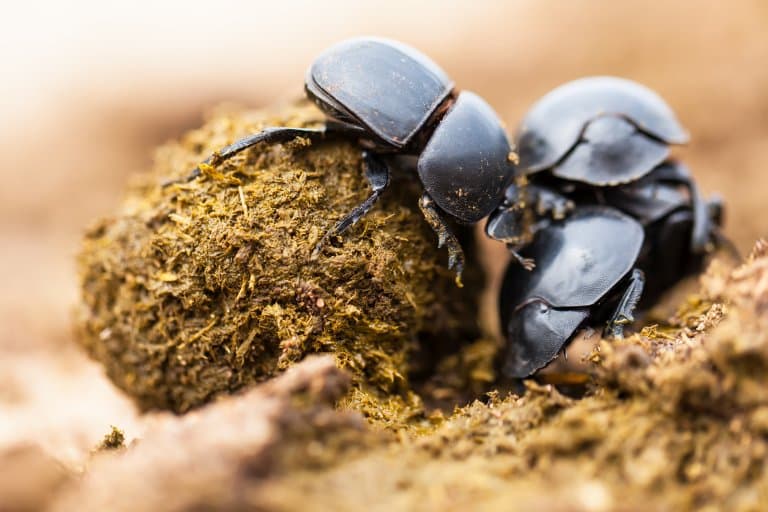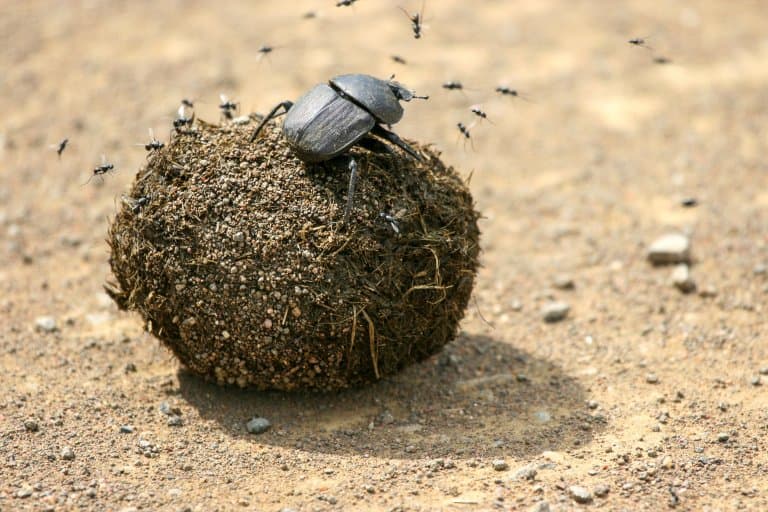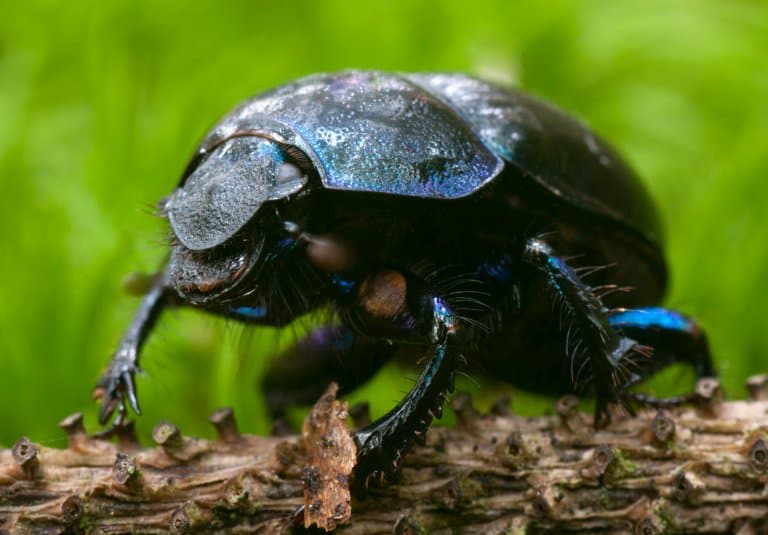Dung Beetle Profile
In 2000 BC, there was no social media. Fads were far less transient, and people could like the same thing for a long time. Around this time, in ancient Egypt, the popular trend was the Scarab beetle.
Ancient Egyptians were crazy for them! They were used as jewellery, as art, as tributes to celebrities, impression seals, and as newspapers.
It’s thought that the significance of this beetle to the Egyptians was linked to rebirth, growth and the circle of life, and although this was based on some erroneous assumptions about its reproduction and its similarity to a mythical celestial process, as a dung beetle, the scarab is all of these things.
Dung beetles are beetles that feed on feces and comprise of over 6,000 different species that belong to different families from the superfamily, Scarabaeoidea.

Dung Beetle Facts Overview
| Habitat: | All biomes except tundra |
| Location: | All continents except Antarctica |
| Lifespan: | Up to two years |
| Size: | Up to 7cm (2.8 inches) long |
| Weight: | Up to |
| Colour: | Usually black or brown, also blues, greens, gold |
| Diet: | Dung |
| Predators: | Almost everything: birds, reptiles, mammals, amphibians, insects |
| Top Speed: | Slow |
| No. of Species: | Over 6,000 |
| Conservation Status: | Over 20% threatened with extinction (IUCN report) |
Dung beetles are found on all continents except Antarctica, living in a huge variety of habitats from deserts to forests, savannahs and grasslands.
They spend their time eating the the dung of herbivores and omnivores, but some of them will also eat decaying plant material, fruit, mushrooms – and some species will even eat millipedes and ants.
The Egyptians revered only a small number of the total species of scarab beetle all over the world. As beetles, they’re part of the most diverse and numerous orders in the animal kingdom, and these particular species play one of the most critical roles in the circle of life.
Yet despite being valued for thousands of years over several cultures, only in the past couple of years has their significance been brought to the attention of the wider conservation-opriented community.
Interesting Dung Beetle Facts
1. There are a lot of them
The dung beetle group isn’t a strictly taxonomic one. The scarab family, Scarabaeidae, makes up the majority of dung beetle species, but still, most of the species in this family don’t eat poop.
Typically, the subfamily of scarab beetles, Scarabaeinae, is considered the “true dung beetles”.
Another subfamily of scarabs, Aphodiinae, makes up most of the rest, and are known as the “lesser dung beetles”, but these are not exclusively dung beetles either.
Then, the closely related family Geotrupidae is another group of earth-boring dung beetles and a minority of these use dung in their burrows.
Together, these three groups sit in the superfamily Scarabaeoidea, but this is a very cluttered and disorganised grouping because it’s based on a behavioural characteristic that appears to have evolved independently.
It’s a lot easier in this instance to divide them unofficially, into their three poo-processing types.

2. There’s rollers, tunnellers and dwellers
One of the key features of rollers is their ability to gather up animal dung and form it into an impressively round ball. This ball is then rolled along the ground to the preferred location and usually buried. From here, it’s either injected with eggs and stored as a brood-feeding medium or used directly as a food source.
This rolling might be why the Ancient Egyptians were so fascinated by the beetles in the first place; it closely resembles the rolling of the sun across the sky by the god Khepri.
Tunnellers, as the name suggests, create impressive poo tunnels that descend from the location of the dung up to a meter below it. Again, they make small dung balls and carry them into these tunnels to use as a source of nutrients for their brood. The Geotrupe family contains the most tunnellers.
Dwellers set up shop right there in the poo and don’t care to move far from it. They’ll try to complete their life cycle on-site and will eat and nest in the dug. Most of the dwellers are in the Aphodiinae subfamily of scarabs. 1
3. Fresh dung helps keep them cool
At midday, surface temperatures in the desert often exceed 60°C.
So fresh, moist balls of dung that contain nutritious liquid are more than just great food, it also helps keep dung beetles cool on hot ground.
Researchers found that dung beetles use their dung ball as a mobile thermal refuge and that ‘beetles on hot ground climbed to the tops of their balls seven times as much as beetles on cooler ground’.
Transporting a mobile thermal refuge in this way means dung beetles don’t need to deviate from their chosen path, and can cross hot terrain without any shelter, simply by being in contact with their dung. 2

4. They’re one of the most important animals on earth
Detritivores are animals that eat (-vore) waste (detritus). And we tend to look down on them because eating waste is generally associated with poor health and a very miserable existence overall. But detritivores form the very key transition in our tropic web that allows animal life to continue living.
As we all know, when making prison hooch, you add bread yeast to sugar water and let it ferment inside the toilet cistern. The yeast eats all the sugar and eventually succumbs to alcohol poisoning as the waste products build to toxic levels and kill all live in the medium.
Without detritivores, this would happen to us mammals, too. Not only would mammal poop build up into a thick, toxic layer across the earth, but plants would have nothing to eat as all the nutrients would be locked up inside it.
Animals like dung beetles convert these nutrients back into soluble forms for plants to feed on, as well as getting them out from under our noses and feet, protecting us from disease and recycling our waste into plant food so that we can go on eating.
And this effect can make or break an ecosystem.
5. They’re ecosystem engineers
Taking all this poop and burying it in the ground has obvious benefits to the local environment. In both agricultural and natural ecosystems, dung beetles are key architects, spreading nutrients, passing seeds around, and aerating the soil with their burrows.
Loosening and nourishing the soils like this boosts productivity, and the breakdown of dung helps reduce parasite load in the mammals who graze on the land. Tunnelling through the dung also helps dry it out, which further reduces the ability of potential pathogens to reproduce. 3
6. They might be the strongest animal in the world relative to size
All this shovelling is hard work, and dung beetles have evolved a serious set of tools to make it work. First of all, their heads are flattened and shovel-like, for obvious reasons.
Their legs are enormous and extremely muscular. Armoured spines act as poo catchers and flattened, powerful rear legs push as the beetle digs or carves out its ball of dung.
The force they can generate with their incredible limbs is truly exceptional. Some reports suggest the dung beetle might be the strongest “pound-for-pound” animal ever recorded, with one study claiming Onthophagus taurus can pull a weight of 1,141 times its weight.
To put their dung rolling into perspective, it would be like the average person pulling six double-decker buses full of people.
Their antennae are also highly specialised, often feathered, to catch the smallest whiff of poo from a long way off. Once they find it, they use specially attuned eyesight to roll it to where they want it. 4

7. At least one dung beetle species can navigate using the stars
Dung beetles have keen eyesight for an arthropod. According to the Professor of Zoology at Lund University, they can see 1,000 times better than a honeybee, and this allows them to navigate using the sky at night, even when there’s no moon.
Using the stripe of the Milky Way, the nocturnal African dung beetle ‘Scarabaeus satyrus’ is able to chart a straight line from the dung pile to their chosen breeding ground, and this discovery represents a recent advancement in the understanding of how many nocturnal insects may find their way through the environment at night. 5
8. They can grow very large
Being from the most diverse order of animals on Earth, it’s hardly surprising that dung beetles exhibit a huge range of morphologies.
The smallest can be as tiny as 2.5mm long, and the largest can be almost 30 times this size. The largest species, from the Heliocopris genus, grows up to around 7cm long and can weigh 45g as larvae.
The adults usually emerge to about half this weight but are capable of pushing dung balls of over 350g. 6

9. They’re also important as food
In northeastern Thailand, water buffalo dung beetles are eaten as a delicacy. Their large size and high protein content make them nutritious and tasty, and while bug-eating cultures are typically associated with Southeast Asia, this has inspired some niche markets in the West, too.
You can now buy a bag of dung beetles, roasted with a bit of salt, for just over $5.
As uneasy as this might make a person, it’s actually one of the more environmentally-friendly dietary fads, as a move away from mammal and bird protein toward that of invertebrates would revolutionise the agriculture industry and create a much more efficient use of land and a healthier source of animal protein.
The more normalised this gets, the less reliant on wasteful and destructive animal agricultural practices we can become. And this, ironically, will help protect dung beetles. 7
10. They’re in decline
Dung beetles almost everywhere face serious challenges when it comes to coexisting with modern agricultural practices.
In the UK alone, there are over 60 species, mostly in the Aphodiinae subfamily. More than half of these are in decline due to both habitat loss and heavy pesticide use.
As recently as 2022, dung beetles have begun to draw the attention of the IUCN, and this is of huge significance in the conservation world.
Classically, the high-profile icons of conservation are those we find cute and cuddly like the panda and the orangutan, and while these are certainly worthy of protection, this bias overlooks the less appealing animals like wasps, spiders, and beetles that roll around in poo.
As such, countless swathes of species that are far more integral to the global ecosystems are being threatened with extinction and are not offered protection to the same degree. This new movement is a step in the right direction to draw attention to just how critical critters are to the safety and longevity of all animals.
Dung Beetle Fact-File Summary
Scientific Classification
| Kingdom: | Animalia |
| Phylum: | Arthropoda |
| Class: | Insecta |
| Order: | Coleoptera |
| Families: | Scarabaeidae, Geotrupidae |
| Subfamilies: | Scarabaeinae, Aphodiinae |
Fact Sources & References
- “Dung Beetles”, Dung Beetels for Farmers.
- Jochen Smolka et al (2012), “Dung beetles use their dung ball as a mobile thermal refuge”, Current Biology.
- Paul Manning, “Dung Beetles Help Keep Ecosystems Healthy”, Frontiers.
- (2010), “Pulling power points the way to the World’s strongest insect”, Queen Mary University of London.
- GRETCHEN CUDA KROEN (2013), “Dung Beetles Navigate by the Milky Way”, Science.
- (1977), “The biology of a giant dung-beetle (Heliocopris dilloni) (Coleoptera: Scarabaeidae)”, Dung Beetle.
- “Edible Buffalo Dung Beetles”, Thailand Unique.
